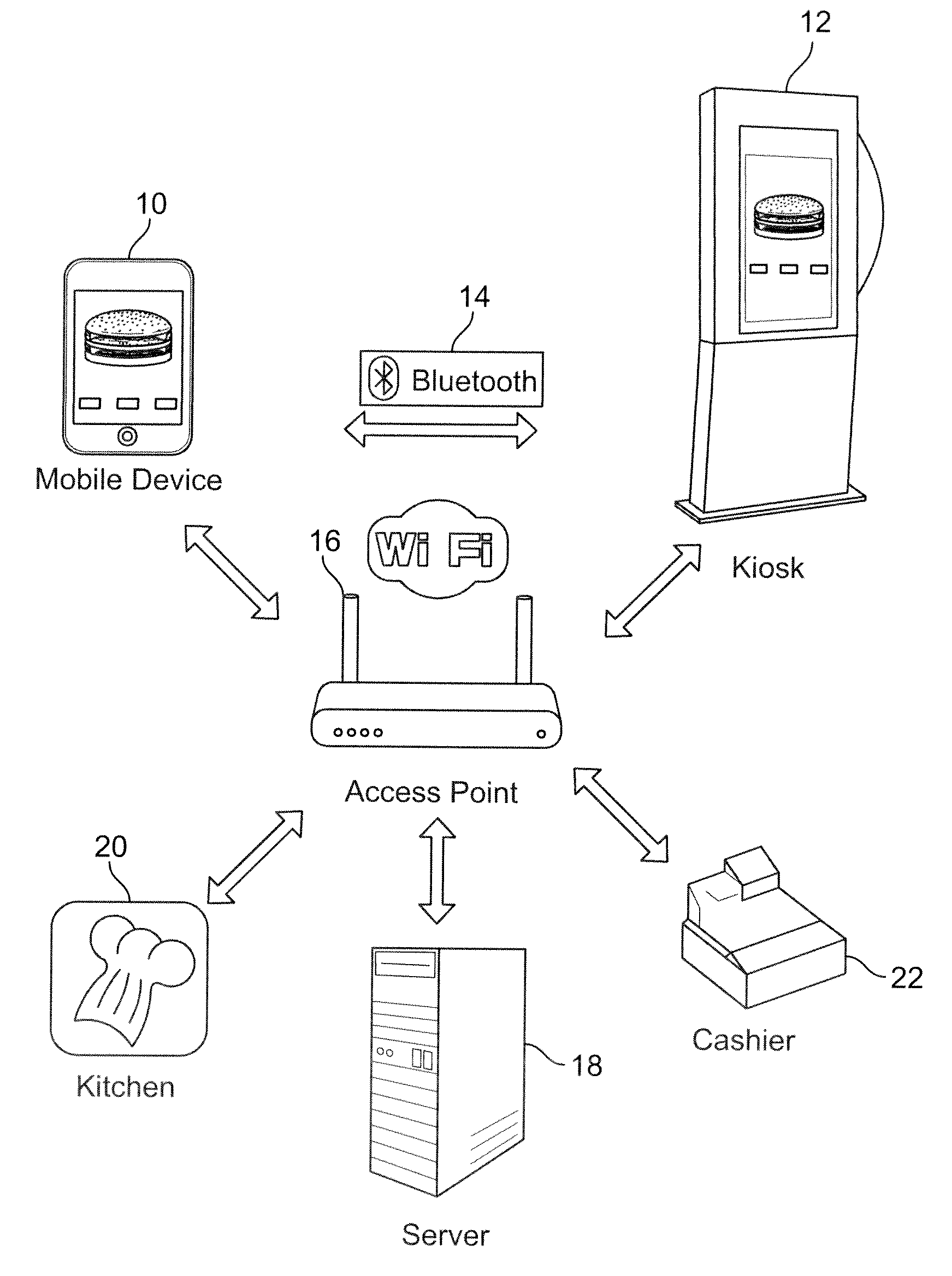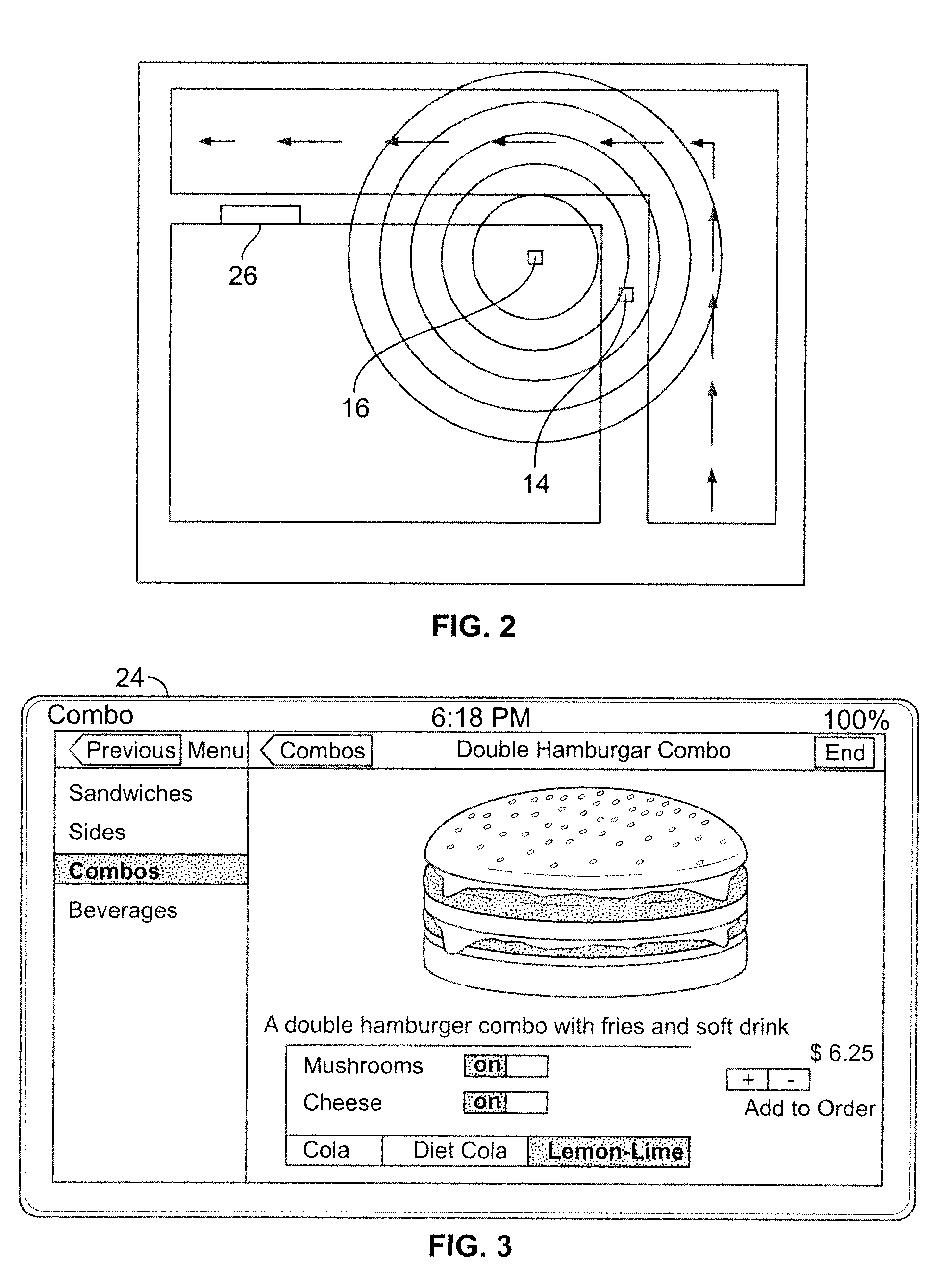Mobile Based Voiceless Drive Through Ordering System and Method
- Summary
- Abstract
- Description
- Claims
- Application Information
AI Technical Summary
Benefits of technology
Problems solved by technology
Method used
Image
Examples
first embodiment
[0028]FIG. 4 depicts a flow diagram of the mobile-based voiceless drive-through ordering system and method. The restaurant prepares its own individualized menu product information 28. Once within range of the restaurant's WiFi transceiver 16, the user opens the mobile-based application 30 on their mobile device 10 and, through the user interface 24, generates a menu product order 32. The user could also generate a menu product order 32 from a remote location, such as home or office. The order information and payment data is stored 34 in the mobile device 10 until the mobile device 10 detects the signal from the Bluetooth transmitter 14 proximity sensor. As the user approaches the drive-through kiosk 12, the mobile device 10 detects the signal 36 from the Bluetooth transmitter 14. The active order submission 38 is detected by the WiFi transceiver 16, which is aware of the mobile-based voiceless application usage and queue position 40. The queue position 40 and the order information a...
second embodiment
[0029]FIG. 5 depicts a flow diagram of the mobile-based voiceless drive-through ordering system and method. The restaurant prepares its own individualized menu product information 48. The user opens the mobile-based application 50 on their mobile device 10 and, through the user interface 24, chooses a destination store 52. The mobile-based application generates a menu product order 54 from the user's choices and calculates the user's estimated time of arrival 56. The order information and payment data, along with the user's estimated time of arrival, is transmitted to the restaurant 58. The restaurant receives the order and payment information and the user's estimated time of arrival 60 and stores it in the back-end data server 18. As the user approaches the drive-through kiosk 12, the mobile device 10 detects the signal 62 from the Bluetooth transmitter 14 proximity sensor and the restaurant's WiFi transceiver 16 becomes aware of the mobile-based voiceless application usage and que...
third embodiment
[0030]FIG. 6 depicts a flow diagram of the mobile-based voiceless drive-through ordering system and method. The user opens the mobile-based application 76 on their mobile device 10 and, through the user interface 24, places an order 78, regardless of the user's location. The user inputs the food items and details 80 and finalizes the order 82. The user must then choose a payment method 84. If the user is using a credit card as the form of payment, the user can input the credit card information 86 into the mobile-based application. Otherwise, the user can prefer to pay in person 88. The user then submits the order and payment information 90. A QR code is generated with the order number 92 and the order and payment information is sent 94 to the back-end data server 18 via the mobile device's 10 3G service or WiFi. The mobile-based application order text displays “Thank you for your order placement. Please save QR code and scan upon arrival at kiosk at your local 'Restaurant Name”96, o...
PUM
 Login to View More
Login to View More Abstract
Description
Claims
Application Information
 Login to View More
Login to View More - R&D
- Intellectual Property
- Life Sciences
- Materials
- Tech Scout
- Unparalleled Data Quality
- Higher Quality Content
- 60% Fewer Hallucinations
Browse by: Latest US Patents, China's latest patents, Technical Efficacy Thesaurus, Application Domain, Technology Topic, Popular Technical Reports.
© 2025 PatSnap. All rights reserved.Legal|Privacy policy|Modern Slavery Act Transparency Statement|Sitemap|About US| Contact US: help@patsnap.com



